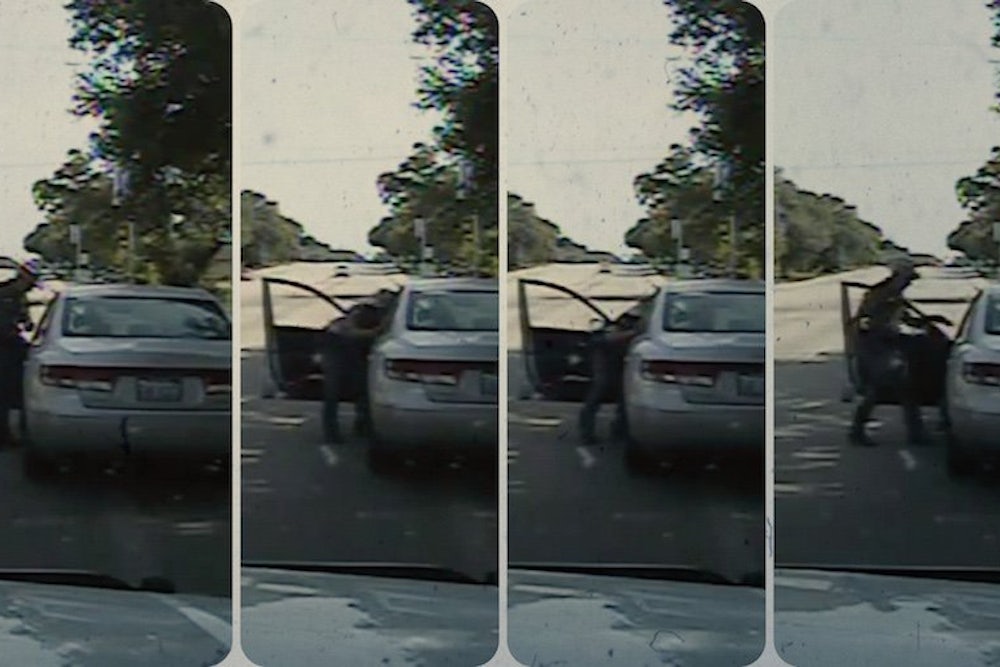For decades, police officers have enjoyed an unbridled right to order motorists out of their vehicles for no reason at all during routine traffic stops. The violent arrest and death of 28-year-old Sandra Bland provides just the latest example of why that rule—and the 1977 Supreme Court case that established the rule—must be revisited.
In Pennsylvania v. Mimms, the Court held that officers did not commit a Fourth Amendment seizure during a traffic stop when, without cause, they ordered a driver out of his car during a stop for an expired license place. When he exited the car, the officers noticed a bulge in his pocket—which turned out to be a pistol he was carrying without a license. Reversing Pennsylvania’s highest court, the justices ruled that drivers could be ordered out of their vehicles for any or no reason at all—and despite the absence of “objective observable facts to support a suspicion that criminal activity was afoot or that the occupants of the vehicle posed a threat to police safety.” Twenty years later, in Maryland v. Wilson, the Court extended the rule, declaring that officers can order passengers as well as drivers out of vehicles during lawful stops.
These two critical decisions did not just guarantee officers wide latitude in traffic stops; they also failed to provide any guidance on the scope of that authority, such as how an officer should respond to a motorist who has committed a petty traffic infraction and peacefully refuses to step out of the vehicle or simply requests an explanation. Without such guidance, even the most minor traffic infractions can quickly devolve into violence.
That’s exactly what happened in Bland’s arrest, as revealed in a dashcam video released this week by the Texas Department of Public Safety. In the video, Bland acknowledges her irritation at being pulled over for allegedly failing to signal before switching lanes, pointing out to the officer that she only changed lanes to get out of his way. State trooper Brian T. Encinia issues her a warning and asks her to put out her cigarette. She refuses, and he asks her to step out of the vehicle. When she declines, he becomes agitated and eventually puts a stun gun to her head. “I’m going to light you up,” he says, and tries to yank her out of the car. Bland was arrested after an extended off-camera struggle, during which she can be heard yelling in pain (part of that struggle was caught on video by a passerby). Three days after her arrest, Bland was found dead in her jail cell. The coroner ruled it a suicide, but the authorities are treating it like a murder investigation.
Bland’s arrest and death are all the more tragic because it requires little effort to imagine the traffic stop unfolding differently. Imagine that, after Bland refused to put out her cigarette, the police officer considered the trivial and nonthreatening nature of her defiance, rolled his eyes, and summoned the power of the law by peaceable and proportionate means: a ticket for her traffic infraction. Imagine that he set his irritation aside in light of his professional duties and stepped away from the car. Imagine that he respected her First Amendment right to be rude to an officer. No violent arrest, no unnecessary jail time. Bland would likely be alive today.
On the video, after the arrest, Encinia can be heard claiming to a fellow officer that he attempted “to de-escalate her and it wasn’t getting anywhere at all.” But the dashcam footage makes patently clear that he did exactly the opposite, and for no reason other than his annoyance at her disrespect. At no point while in the car did Bland threaten his safety. And despite Bland's repeated entreaties, Encinia refused to provide her any explanation for his demand that she exit the car.
In Mimms, the Supreme Court dismissed the idea that ordering a driver out of her car intruded on her personal liberty, declaring that the intrusion “can only be described as de minimis” because “the driver is being asked to expose to view very little more of his person than is already exposed.” This is a shallow privacy analysis in place of the robust protection analysis that we need to promote the physical safety of both officers and motorists in these cases—cases in which there is no objective reason to allow police, at their discretion, to trigger physical confrontation.
Lawmakers have the power to correct the Mimms rule to reflect this need. One straightforward solution would be to enact laws that require an officer to reasonably perceive a threat to his safety or the commission of a crime before ordering an occupant out of a vehicle for a minor traffic offense. At a minimum, officers could be required to provide motorists a brief explanation for the order and their intent. By passing sensible laws that preserve appropriate boundaries between police and citizens, legislators can prevent petty, noncriminal infractions from ending up like Bland’s did.
Common sense should compel police officers in heated situations to do what any ordinary citizen would be required to do: listen, take a deep breath, and cool down. But common sense sometimes fails. That’s when our laws need to kick in.
